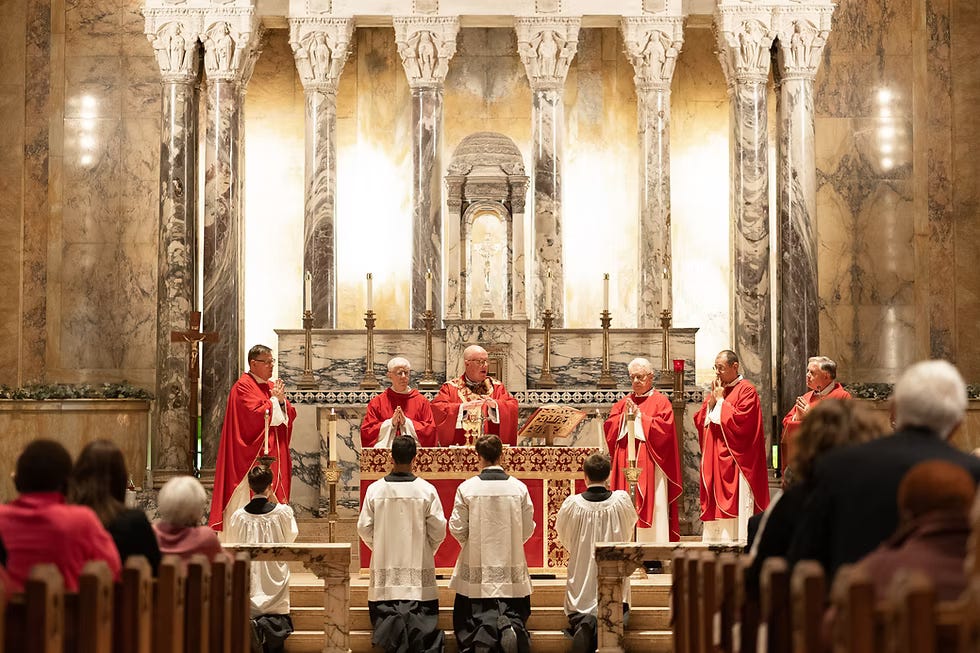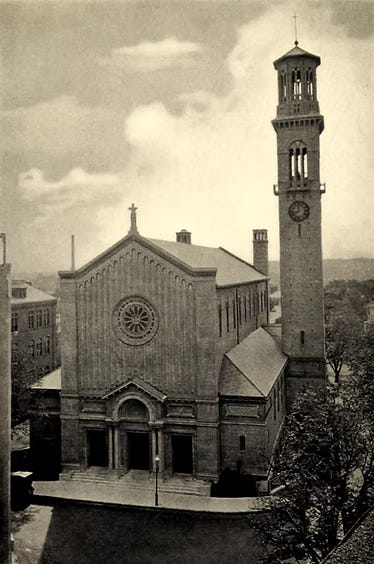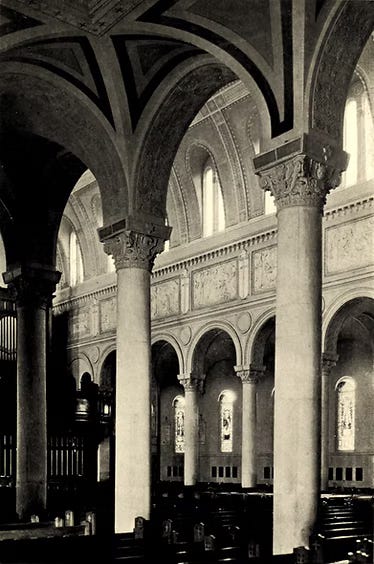St. Paul’s Parish Marks 150 Years of Faith
On the morning of Sunday, October 5th, I walked into St. Paul’s Parish in Harvard Square for Mass, as I do every Sunday. What greeted me that day, however, was something altogether different—a symphony of light and beauty that defies my capacity for language.
In commemoration of the parish’s sesquicentennial anniversary, what would have been an ordinary Sunday Mass became something elevated and transcendent. The choristers and Schola of the adjoining choir school filled the Gothic nave with sacred song, while His Excellency, The Most Reverend Richard G. Henning, S.T.D., Archbishop of Boston, presided at the altar. More than a dozen clerics concelebrated, including several former St. Paul’s priests. The pews were filled to bursting, with latecomers standing gladly in the narthex.
It was an image of the Church universal. Professors prayed beside their students; the newest freshmen beside alumni from generations past; veiled women, men in suits, and others in street clothes, all united in worship. Just as at the Nativity both wise men and simple shepherds were gathered, so too here the full breadth of humanity knelt together before the altar.
For a moment I wondered what John Lee, Harvard’s first Catholic student, who in the nineteenth century paid fines for refusing to attend Protestant services, might have thought if he could see this. Perhaps, as he suffered those penalties for conscience’s sake, he was granted some faint glimpse of what his testimony would one day make possible: a flourishing Catholic community in the heart of Harvard Square.
During his closing remarks, Archbishop Henning reflected on the openness and vitality he witnessed. “I saw all three of your doors thrown open to the world around you,” he said. “There is a revival of the Faith going on, particularly among the young… [who] share the light of God with the world.”
That revival is more than rhetorical. According to The Harvard Crimson’s annual freshman survey, Catholicism remains the most common faith among incoming students. St. Paul’s has also seen remarkable numbers of converts—around forty each year for the past several years. It may surprise some that the world’s most elite university should yield so many converts to a faith often caricatured as medieval or obsolete. But perhaps this is fitting. The wise men, after all, found their way to Bethlehem just as the shepherds did.
The Archbishop’s homily centered on the call to spread the light of Christ into the world, a mission St. Paul’s has embraced faithfully for 150 years. For Harvard’s Catholic students, the parish is more than a church—it is a sanctuary of sanity and grace amid the intellectual storms of the Square. During the Mass, the choir sang like the very angels of the Lord, their voices joined by organ and trumpet in a sound that seemed to touch eternity.
At one moment, I noticed a small girl standing before a stained-glass window of St. Athanasius, above which is written Et Incarnatus Est—“And He became flesh.” She could not have been more than three or four, but she stood transfixed, her delighted songs mingling with the bells at the altar. It called to mind Our Lord’s own words: “Suffer the little children, and forbid them not to come to me: for the kingdom of heaven is for such.”1
After Mass, the congregation poured into the sunlight outside, a chorus of languages—English, French, Spanish, Igbo, Amharic. I spoke with an elderly Ethiopian woman who smiled and told me, “In my country, we never leave Mass without kissing the priest.”
Father William Kelly, S.T.D., pastor of St. Paul’s, told The Harvard Salient, “This Mass was a great thing for us here at St. Paul’s—and really for the whole Church—to have all these people here to celebrate this great anniversary.” When I later asked Archbishop Henning for any final comment, he smiled warmly and said simply, “Just communicate how delighted I am with the faith of this community, and how the Faith is being lived here in Cambridge.”
Above the central portal of St. Paul’s are carved the words: “The Church of the Living God, the Pillar and Ground of Truth.” That inscription stands as quiet rebuke to a university that has, in recent decades, treated “truth” as something malleable or self-defined. At St. Paul’s, truth is not manufactured or negotiated; it is received—incarnate in beauty, revealed in love, sung in Latin, and illumined by the flicker of candles and the scent of incense.
As I walked back through Harvard Square that morning, the sound of the bells still echoing faintly behind me, I thought of how rare such beauty is in our time—and how desperately it is needed. Harvard may be a flawed institution, as all human ones are, but what I saw at St. Paul’s gives me hope that from within its walls might yet emerge students and scholars who seek the transcendentals: the True, the Beautiful, and the Good.
Matthew 19:14 DRA






"After God had carried us safely to New England, and we had built our houses, provided necessaries for our livelihood, reared convenient places for God's worship, and settled the civil government; one of the next things we longed for, and looked after, was to advance learning, and perpetuate it to posterity; dreading to leave an illiterate ministry to the churches, when our present ministers shall lie in the dust."
In this statement, attributed to the founders of Harvard, there is a very clear order of priorities that the colonists followed upon landing here in the New World. Shelter, food & clothing, God, government, and then ... advanced learning.
The foundations stones of our society are shelter, food, God, and government. They come first. All else is built on top of the foundation to edify the foundation and to glorify the foundation. All of Harvard's courses, therefore, should be chosen with that in mind. They should be added on top of the solid foundation of shelter, food/clothing, God, and government.
Some of today's coursework, however, seems to be oriented more towards chipping away at the foundation, rather than building on top of it The entire queer curriculum, including the latest addition of "Lahore V." is only the latest example. The curriculum chips away at the foundation of society, rather than building on top of it. As such, it runs counter to Harvard's founding priorities and should be discarded.
https://christianheritagefellowship.com/the-christian-founding-of-harvard/#ftnref1
This is a remarkably beautiful and inspired article.
Give us more, please!